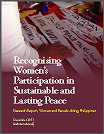 The Beijing Platform for Action calls upon the media and governments to ensure that women have equal participation in and access to the media, and to address stereotypical representations of women in the media. However, as the five-yearly Global Media Monitoring Project1 reports show, women's access to the media is progressing at a glacial pace. To help speed progress, UNESCO has joined with civil society organisations to launch the Global Alliance on Media and Gender (GAMG) following a three-day forum in Bangkok in December 2013.
The Beijing Platform for Action calls upon the media and governments to ensure that women have equal participation in and access to the media, and to address stereotypical representations of women in the media. However, as the five-yearly Global Media Monitoring Project1 reports show, women's access to the media is progressing at a glacial pace. To help speed progress, UNESCO has joined with civil society organisations to launch the Global Alliance on Media and Gender (GAMG) following a three-day forum in Bangkok in December 2013.
The alliance has three objectives, as outlined in the draft framework:
- “To strengthen international and regional cooperation to promote gender equality and women’s empowerment in and through the media - among all stakeholders working together to drive change globally;
- To follow-up and systematically monitor and evaluate one of the critical areas of concern of the Beijing Declaration and Platform for Action: Women and the Media Diagnosis, and its strategic objectives; and
- To develop, sustain, build priorities amongst a broad donor, government funding and development agency framework on gender and media.”
The alliance has grown out of the World Summit on the Information Society and benefits from the flexible open structures that the summit pioneered. As such, UNESCO, partnering with UN Women and other key regional and international organisations, is taking the lead, but anyone can register their interest in the Alliance and become a member. As with WSIS and its successor the Internet Governance Forum, the Alliance provides a space for state and non-state actors to meet, discuss and set standards in an informal setting without the pressure for 'results' that often means that lowest-common-denominator agreements are reached, without the mechanisms or funding required for implementation.
Organisations that are currently in the alliance include the Thai public broadcaster and Al-Jazeera. It thus provides feminists with a crucial platform for engaging with those responsible for implementing Section J on a footing that is, at least institutionally (if not in terms of resources) equal. As NGOs who have participated in the IGF process have reported (see (LINK) GenderIT.org2) this can be both challenging and productive.
GenderIT.org editor Katerina Fialova says, “In 2015, the CSW will undertake the +20 review of progress made in the implementation of the Beijing Declaration and Platform for Action. In +10 and +15 reviews, there was a lot of outcry by women's media practitioners and advocates: where is women’s “J” spot? De-prioritization of section J and attention given to media and internet issues have consequently been reflected in agendas of UN agencies, donors and women's organization. So GAMG can provide important platform for critical and collective review of Section J and for locating communication and internet rights as central to the work of women’s rights movements."
What is needed now is for feminist organisations, particularly those working on media, to have a strong presence at the alliance, to be able to influence discussions and debates and, hopefully, use this new avenue to make the promises of a more equitable media environment, outlined in Section J, closer to becoming reality.
See http://www.unesco.org/new/en/communication-and-information/crosscutting-priorities/gender-and-media/global-forum-on-media-and-gender/homepage/ for more information.
1Co-ordinated by the World Association for Christian Communication (WACC), the GMMP monitors the presence of women in the news in over 100 countries.
2GenderIT.org is an online journal that looks at issues of ICTs and gender, concentrating on issues of internet governance and policy-making.





 The
The 
 Isis Resource Center holds one of the largest feminist collections of materials in the Global South. With 40 years of publication experience, Isis holds a vast collection.
Isis Resource Center holds one of the largest feminist collections of materials in the Global South. With 40 years of publication experience, Isis holds a vast collection.